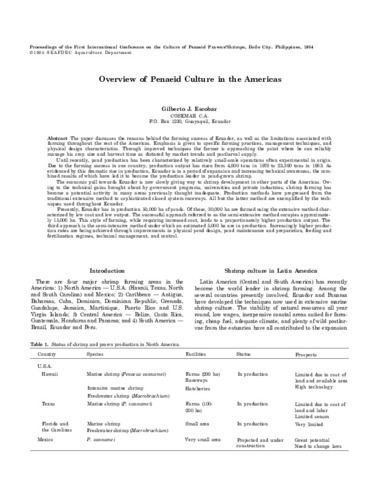Overview of penaeid culture in the Americas

ရှာဖွေ/ဖွင့်ပါ။
ရက်စွဲ
1985စာရေးသူ
Page views
436
Share
စိတ္တဇ
The paper discusses the reasons behind the farming success of Ecuador, as well as the limitations associated with farming throughout the rest of the Americas. Emphasis is given to specific farming practices, management techniques, and physical design characteristics. Through improved techniques the farmer is approaching the point where he can reliably manage his crop size and harvest time as dictated by market trends and postlarval supply.
Until recently, pond production has been characterized by relatively small-scale operations often experimental in origin. Due to the farming success in one country, production output has risen from 4,800 tons in 1978 to 23,390 tons in 1983. As evidenced by this dramatic rise in production, Ecuador is in a period of expansion and increasing technical awareness, the combined results of which have led it to become the production leader in pond-grown shrimp.
The economic pull towards Ecuador is now slowly giving way to shrimp development in other parts of the Americas. Owing to the technical gains brought about by government programs, universities and private industries, shrimp farming has become a potential activity in many areas previously thought inadequate. Production methods have progressed from the traditional extensive method to sophisticated closed system raceways. All but the latter method are exemplified by the techniques used throughout Ecuador.
Presently, Ecuador has in production 50,000 ha of ponds. Of these, 30,000 ha are farmed using the extensive method characterized by low cost and low output. The successful approach referred to as the semi-extensive method occupies approximately 15,000 ha. This style of farming, while requiring increased cost, leads to a proportionately higher production output. The third approach is the semi-intensive method under which an estimated 5,000 ha are in production. Increasingly higher production rates are being achieved through improvements in physical pond design, pond maintenance and preparation, feeding and fertilization regimes, technical management, and control.
Suggested Citation
Escobar, G. J. (1985). Overview of penaeid culture in the Americas. In Taki Y., Primavera J.H. and Llobrera J.A. (Eds.). Proceedings of the First International Conference on the Culture of Penaeid Prawns/Shrimps, 4-7 December 1984, Iloilo City, Philippines (pp. 23-26). Iloilo City, Philippines: Aquaculture Department, Southeast Asian Fisheries Development Center.
